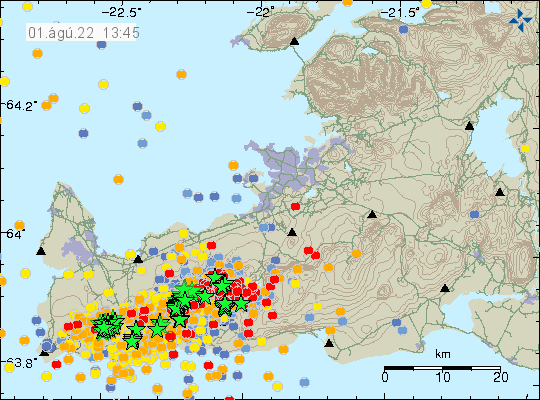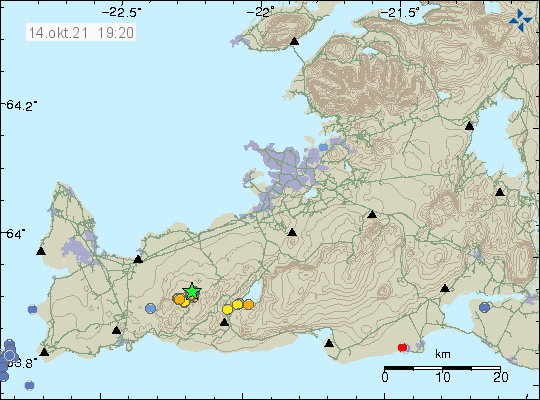Today (21. December 2022) an earthquake with magnitude of Mw3,4 took place in Krýsuvík-Trölladyngja volcano. This earthquake is because of inflation in Fagradalsfjall volcano. This possibly means that the inflation in Fagradalsfjall volcano is reaching critical point and might result in a eruption soon, when that point is reached is difficult to know.
Continue reading “Earthquake swarm in Krýsuvík-Trölladyngja volcano”
Update on 5-August-2022 on the eruption in Meradalir valley
This is a short update because not much has changed in the last 24 hours in the eruption in Meradalir valley in Fagradalsfjall mountain.
- The eruption is now in 120 meter long eruption fissure. Currently the output of the eruption is around 18 m3/sec according to yesterday’s measurements.
- The new lava has now flowed over the lava from last year (2021) and into eastern Meradalir. This is about 1 km distance that river of lava has flowed. Image of that can be found here on Facebook.
- According to chemical analyse of the magma. This is the same magma that was erupting when the eruption in the older crater stopped erupting in September. This shows that this magma is older and the new magma has not yet reached the surface.
- Fissures on the ground north-east of the eruption site have started to move and getting wider according to experts that are in the area. This strongly suggests that an eruption is about to happen soon in that location. When it starts is impossible to know. But this is going to close one way to the eruption and if eruption starts in new location south of the crater, seeing and viewing this eruption might start to get difficult or impossible, at least the part in Meradalir were the current eruption is happening now.
I think that is all for this Friday. Next update is going to be on Friday 12-August unless something major happens in this eruption and that might just happen.
Donations
Please remember to support my work with donations. Thanks for the support. 🙂
Update on 1-August-2022 on the earthquake swarm in Fagradalsfjall mountain
This is a short update on the earthquake swarm in Fagradalsfjall mountain and nearby area. This is written on 1-August-2022 at 13:47 UTC.
The situation on Reykjanes peninsula is always updating so information in this article can be in part or in whole get obsolete quickly. Largest earthquake during the night had a magnitude of Mw4,7. This might not be the largest earthquake today, since larger earthquakes are always a possibility.


GPS data have started to show a large displacement over the last 48 hours. The 24 hour GPS displacement can be found here and 8 hour GPS displacement data can be found here (find Reykjanes peninsula). This shows that magma is pushing its way though the crust at fast speed, but has not yet broken up trough the crust. When that happens is impossible to know, but this might not be a long wait based on the speed the magma is going. Current depth of the magma is around 2 to 4 km.
Deep inflation detected in Fagradalsfjall mountain
According to a news report today (16-November-2021) inflation has been detected deep under Fagradalsfjall mountain, that is part of Krýsuvík-Trölladyngja volcano system. This inflation suggests that an eruption might start again in Fagradalsfjall mountain, it remains impossible to know when such an eruption might start. Since there is a lot that suggest this inflation is because of magma collecting at depth under Fagradalsfjall mountain. When or if that results in a eruption in the future is impossible to know.
This inflation is now large enough to be seen on satellite images that monitors deformation in the upper crust. In the upper crust this deformation appears small, but that is not all the story in this.
Icelandic News (in Icelandic)
Gosið enn í dvala – Mæla litlar hreyfingar á miklu dýpi (Rúv.is)
Donations
Please remember to support me. In November I am really broke in November because of computer repairs. Thanks for the support. 🙂
Fewer earthquakes close to Keilir, no eruption in Fagradalsfjall mountain for almost one month
Earthquake activity continues close to Keilir mountain. But it remains at depth of 5 to 6 km and doesn’t show any sign that it is about to move to the surface. More than 10000 earthquakes have been recorded and 18 earthquakes have been recorded with magnitude above Mw3,0. This is according to Icelandic Met Office.

The eruption in Fagradalsfjall mountain (more information at Krýsuvík-Trölladyngja website at Global Volcanism Program) has not been active since 19-September-2021 and there are no signs that the eruption is about to restart soon. Global Volcanism Program no longer updates its information for this volcano as an active eruption. Icelandic scientists in eruptions have not declared the eruption over. It should be expected that the eruption in Fagradalsfjall mountain is over for now, but it can start again at the same location or at new location in few weeks time or maybe even few years from now.
Update on the eruption in Fagradalsfjall mountain on 19-August-2021
This is a short update on the five month eruption day in the Fagradalsfjall mountain that is part of Krýsuvík-Trölladyngja volcano system.
- The eruption continues its strange cycle of not erupting for few hours and erupting for few hours.
- The consequence of this type of eruption is that the lava doesn’t flow that far from the crater. It just piles up next to the crater making the structure ever higher. I am currently estimating (this is a guess and might be wrong) the crater at 200 meters high (-+ 50 meters).
- The eruption has now been going on for five months. Holuhraun eruption in Bárðarbunga volcano in 2014 to 2015 lasted for six months.
- At the writing of this article there are no new craters open but it doesn’t rule out that new crater might have opened but are hidden under the amount of lava that is around the main crater. As there are some extreme large caves in this lava field. Allowing for a lot of space for new crater to form and start erupting unnoticed.
There are no more updates of the eruption at the writing of this article. That might change without warning but I don’t know if that is going to happen.
Update on the eruption in Fagradalsfjall mountain on 10-August-2021
This is a short update on what is going on the eruption in Fagradalsfjall mountain that is part of Krýsuvík-Trölladyngja volcano system.
- The eruption continues as before with few hours of eruption and few hours of no activity. (This is my personal view of the situation) Each event is an active eruption as it would happen with any other volcano. The time between eruptions now is just shorter than in any volcano in Iceland. Its hours, not decades between eruption. I don’t know why this is happening like this.
- Cracks have appeared in the viewing area hill closest to the erupting crater. Why this is happening is unclear. There are two explanations for this. The first one is that this are tension cracks because of the eruption and lava flows nearby to this hill . The second explanation is that this is deformation cracks because magma is about to start erupting in this part of the hill. Formation of new cracks was observed early on in the eruption in Fagradalsfjall mountain few days before an eruption started in that area.
- There is now slightly less lava flowing from the crater. Current flow is up to 9m3/sec according to latest reports about the lava flow. This studies are done by Earth Science of University of Iceland and Icelandic Metrology Office.
This eruption remains small. Currently it is even smaller than Hekla volcano 2000 eruption that was the smallest eruption in Hekla in recorded history (according to the news). While the eruption remains this small the lava is not going to flow far or is going to do so slowly. Most of the lava is just going to build up next to the crater and next nearby area.
People continue to walk out in the lava and that is extremely dangerous. The lava field, where it is deep enough has large caves full of 1100C hot lava and if the roof breaks and people fall into it there is no saving anyone from this. Just break in the lava field crust allows for lava flows to break out with same deadly consequences.
Unconfirmed report about ash cloud off the coast of Krýsuvík-Trölladyngja volcano (Krísuvíkurberg)
This is possible mistaken reporting. There have been reporting of ash clouds or steam clouds off the coast during the evening of 7-August-2021. This would be in the volcano system Krýsuvík-Trölladyngja.
The ash cloud or steam cloud would indicate an activity off the coastline or possible eruption activity in the ocean. Explosive events like that appear a lot more clearly as harmonic tremor on SIL stations and according to news reports nothing has been seen so far in the harmonic tremor data. There have been no earthquake activity in the area where the clouds are supposed to have been seen.
The coast guard has been sent to this area, as they where nearby anyway. I don’t know if anything has been reported so far. The weather is fine in south Iceland and I don’t think there is a lot of ocean waves, but as this is the Atlantic ocean there can be ocean waves even if there is no wind, since the ocean waves can arrive from parts of the ocean with bad weather thousands of kilometres away.
If anything new is reported I am going to update this article or write a new one.
